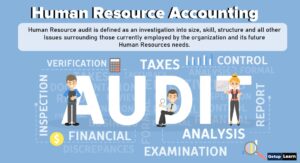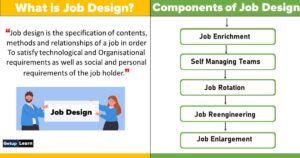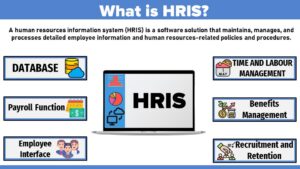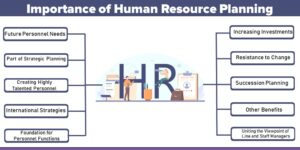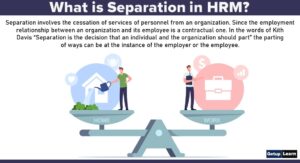Table of Contents
What is Job Analysis?
Job Analysis is basically the process of identifying the nature of jobs. Job analysis refers to various methodologies for analyzing the requirements of a job. The main purpose of conducting job analysis is to prepare job descriptions and job specifications which in turn helps to hire the right quality workforce into the organization.
It helps to understand the qualities required by employees. It is a process used to collect information about the duties, responsibilities, necessary skills, outcomes, and work environment of a particular job.
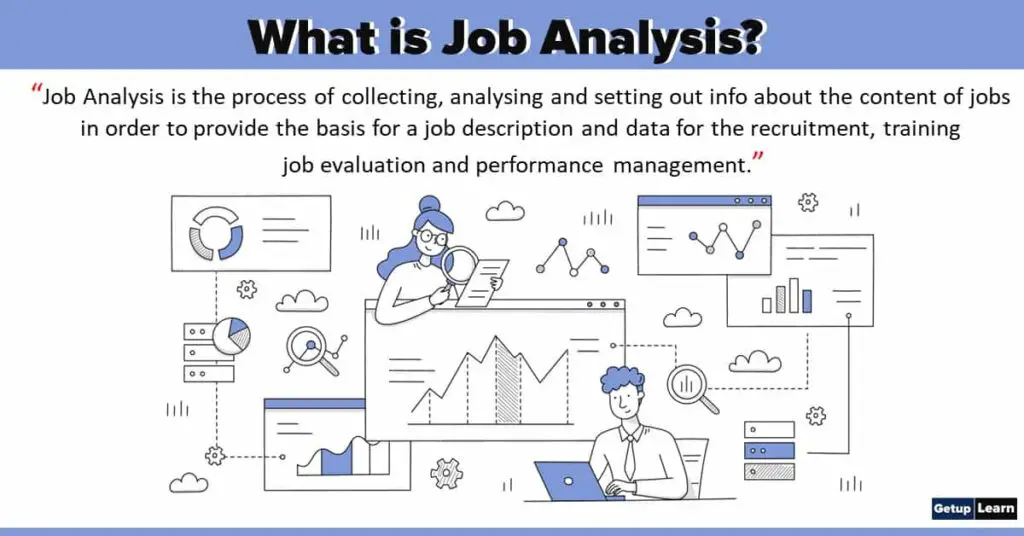
Job Analysis involves the identification and precisely identifying the required tasks, the knowledge and skills necessary for performing them, and the conditions under which they must be performed.
Job analysis and job description both are important parts of studying a particular job from various important perspectives, so as to get complete information about a particular job or different jobs. It helps human resource activities as it minimizes various deficiencies in various recruitment and selection processes.
The real value of job analysis begins as the information is compiled into job descriptions and job specifications for use in virtually all human resource activities. Job analysis is also useful in identifying job factors and duties that may contribute to workplace health and safety issues.
Further, a job description provides information about the tasks, duties, and responsibilities of a job. Moreover, it gives information about job code, pays grade, exemptions and necessities in a particular job. Both job analysis and job description are important concepts in the human resource management process.
Definition of Job Analysis
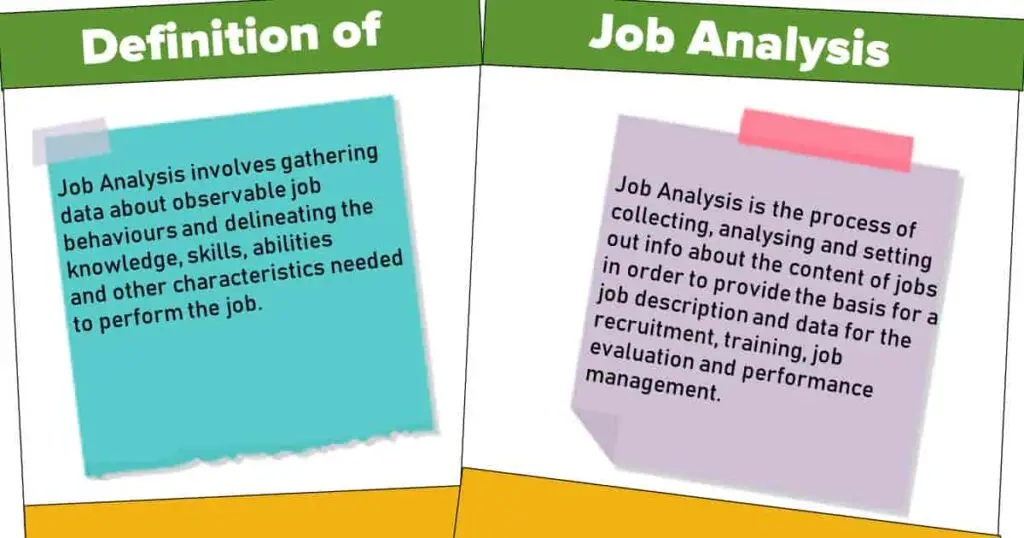
These are some simple definitions of job analysis:
[su_quote cite=”R.J. Harvey”]Job Analysis involves gathering data about observable job behaviours and delineating the knowledge, skills, abilities and other characteristics needed to perform the job.[/su_quote]
[su_quote cite=”Michael Armstrong”]Job Analysis is the process of collecting, analysing and setting out info about the content of jobs in order to provide the basis for a job description and data for the recruitment, training, job evaluation and performance management.[/su_quote]
[su_quote cite=”Michael J. Jucious”]Job Analysis refers to the process of studying the operations, duties and organisational aspects of jobs in order to derive specifications or as they are called by some Job Descriptions.[/su_quote]
[su_quote cite=”Edwib B. Flippo”]Job Analysis is the process of studying and collecting info relating to the operations and responsibilities of a specific job.[/su_quote]
[su_quote cite=”Richard Henderson”]Job Analysis involves the identification and precisely identifying the required tasks, the knowledge, and skills necessary for performing them and conditions under which they must be performed.” From the above definitions, it is clear that Job Analysis is basically the process of collecting data and then analyzing this data in terms of duties, responsibilities, skills, knowledge, degree of risk, etc.[/su_quote]
Objectives of Job Analysis
Job Analysis basically is a process wherein the data related to jobs are collected and analysed to identify which tasks are to be performed and the required knowledge and skills to perform the jobs. Job analyses produce information used for writing job descriptions and job specifications. These are the objectives of the job analysis given below:
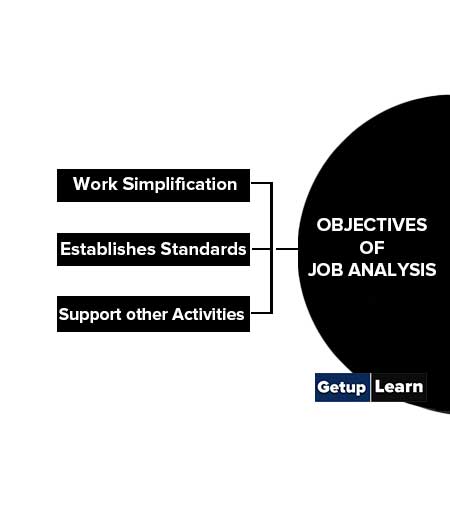
Work Simplification
One of the main purposes of Job Analysis is to simplify the work which has to be performed and explain the process and methods in a manner that is easy to understand. This would ensure that the employees are able to understand the work that has to be undertaken which thereby improves their productivity.
Establishes Standards
Job analysis also facilitates the recruitment procedure as under it, a detailed study of the job is undertaken and mini- mum required skills and qualifications are determined. As a result, standards of effective performance that are established help the management to find out suitable employees for the job which has to be performed.
Support other Activities
Job Analysis supports other personnel activities such as recruitment, selection, training, development, performance evaluation and other such activities.
Scope of Job Analysis
Following is the scope of job analysis:
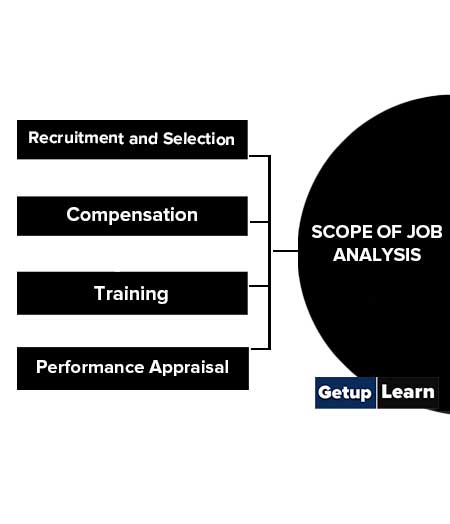
Recruitment and Selection
Job analysis provides information about what the job entails and what human characteristics are required to carry out these activities. Such job descriptions and job specification information are used to decide what sort of people to recruit and hire.
Compensation
Job analysis information is also essential for estimating the value of and appropriate compensation for each job. This is so because compensation, (such as salary and bonus) usually depends on the job’s required skill and education level, safety hazards, degree of responsibility and so on-all factors that are assessed through job analysis.
Job analysis provides the information determining the relative worth of each job so that each job can be classified.
Training
Job analysis information is also used for designing training and development programs because the analysis and resulting job description show the skills and therefore training that is required.
Performance Appraisal
A performance appraisal compares each employee’s actual performance with his or her performance standards. It is often through job analysis that experts determine the standards to be achieved and the specific activities to be performed.
JOB ANALYSIS Process of defining jobs in terms of tasks, behaviours and personal requirements.
Features of Job Analysis
Let’s discuss the features of job analysis:
- Job analysis is a process through which relevant information about various aspects of a job is collected and then the tasks which are to be performed are identified.
- It defines the role, context, conditions, behaviour, performance standards and responsibilities of a job in a systematic manner.
- It measures the value and contribution that a job makes towards the growth of an organisation.
- It establishes interconnections between various jobs which are performed in an organisation.
- It helps in developing a profile of the job which acts as a basis for developing job descriptions and job specifications.
- It also helps the management in understanding the impact of various environmental factors on individual jobs.
- It helps in simplifying the eligibility criteria of the jobs which are evaluated by removing those skills from the eligibility criteria which are not important for the performance of a job.
- It also aids in improving the job that is being analysed by enabling job re-engineering and job enlargement and improving the satisfaction level of employees.
Uses of Job Analysis
The following are the uses of job analysis. The following are the various areas where the information collected for Job Analysis is used:
- Job Evaluation
- Job Design
- Job Classification
- Job Description and Specification
- Human Resource Planning
- Recruitment and Selection
- Training and Development
- Performance Evaluation
- Wage and Salary Administration
- Safety and Health
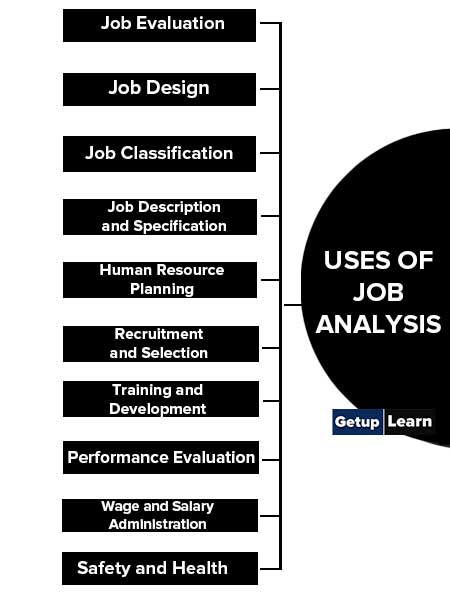
Job Evaluation
Job Evaluation is a system of ranking jobs in a firm on the basis of their relevant characteristics, duties and responsibilities. Through Job evaluation, the relative worth of the job is measured which helps in determining the pay scale of the jobs.
Job Analysis enables the management to determine the pay which is appropriate for the job as well as ensures that the pay offered is able to keep the talented employees in the organisation.
Job Design
Job design is an activity of bringing together various tasks to build a job. This process is influenced by factors such as requirements of jobs, employee satisfaction and the goals of the organisation.
Job Analysis helps the management to identify the activities which are to be performed as well as how they can be made more effective by replacing a specific task with other relevant tasks. In this way, the job which was earlier designed can be redesigned and made more effective.
Job Classification
Under the activity of job classification, the type of activities that are of similar nature is classified and grouped together under the same group. The classification can be done on the basis of the level of difficulty, authority, responsibilities and accountability.
As Job Analysis under- takes a thorough evaluation of the job, the activity of classification gets simplified. Job Classification in turn helps the organisation to determine and design appropriate training and development programs for employees performing similar activities.
Job Description and Specification
At the end of the process of Job Analysis, a Job Description is derived which is a written statement about the findings of the Job Analysis. It includes the information related to job title, duties, authorities, responsibilities, accountability, relations with other jobs, specifications of working and job conditions as well as location.
On the other hand, the second outcome of Job Analysis, that is the Job Specification, describes the skills knowledge, qualifications and other characteristics which are required to be performed.
Human Resource Planning
Human Resource Planning involves choosing the right person, for the right job at the right cost which is decided on the basis of the goals and objectives of the organisation. Job Analysis helps the management to understand what type of person is required for a job.
It helps the management to achieve a balance between the demand for and the supply of Human Resources by providing information about the quality of personnel required for a job.
Recruitment and Selection
Job Analysis helps in preparing a detailed profile of the job in case if a vacancy arises. Job Analysis also helps the company to determine if such a post should be continued or not. Further, Job Analysis also helps in recruitment and selection as through it, the management can determine the skills which are required for a said job and where the person possessing such skills would be available.
It also helps the management by specifying the selection criteria for the job which would help the mgt to select the suitable candidate for the job.
Training and Development
Through Job Analysis, the management can determine the exact skills and knowledge required for the job. In case the employees with required skills are not available, the organisation can choose the candidates from available employees who can be trained.
Moreover, through Job Analysis, the organisation can also design training programs by choosing appropriate content of training, duration as well as the type of training.
The management could also determine the skills that the employees might require in future for undertaking the specific job which would help in the long term development of the organisation and the employees.
Performance Evaluation
Job Analysis analyses the job in detail and sets standards that are to be achieved for the efficient performance of the job. Job Analysis also provides information about the duties and responsibilities of the job.
These decisions play an important role in determining the pay of the job, the level of job in the organisation, possible promotions, the type of disciplinary actions which can be taken and from where the employee feedback can be obtained.
This would also help the management to avoid any allegations of discrimination undertaken by them.
Wage and Salary Administration
Job Analysis also helps the management to determine the value a job adds to the total value of the organisation. Through Job Analysis, the management is able to determine the duties, responsibilities, level of difficulties, skills required, qualifications as well as the location of the job.
It also helps in the determination of appropriate compensation packages for the employees who would be appointed. It also ensures that the payment which is determined is attractive enough to attract new talent as well as retain them in the organization.
Safety and Health
As Job Analysis analyses the exact nature of the job, the type of activities that are involved as studied in detail which helps in the determination of the risks that are involved. This helps the management to identify the hazards involved in the jobs and allows them to take precautionary measures for ensuring the safety and welfare of the employees.
Such measures might reduce the number of accidents that might occur. Moreover, necessary safety training programs can also be designed on the basis of the types of risks that an employee might be exposed to.
Process of Job Analysis
In order to undertake Job Analysis, a specific job is divided into small parts and is analysed in detail by collecting necessary information related to it. The following are the steps involved in the process of job analysis:
1.Determine the Purpose of Job Analysis
2.Gathering Background Information
3.Choosing Representative Jobs for Analysis
4.Collecting Relevant Job Information
5.Review of Information that is Collected
6.Developing Job Description and Job Specification
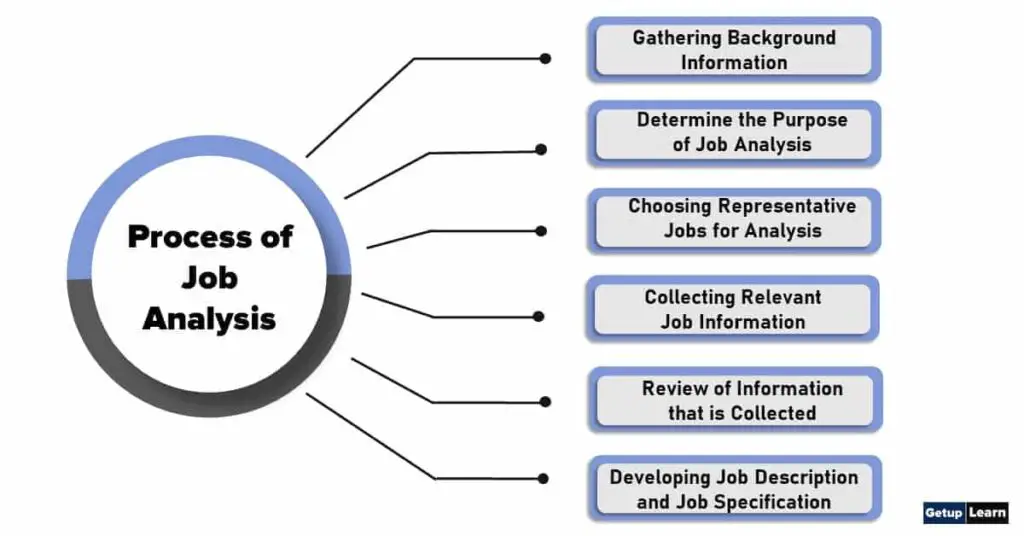
Determine the Purpose of Job Analysis
Before starting the process of job analysis, it is important to determine for what purpose the information collected through job analysis would be used. Once the purpose is determined, the organisation would have a clear idea about the type of information that has to be collected.
For e.g. If the purpose of undertaking job analysis is to improve the safety measures that are to be taken, then the information collected using job analysis would be pertaining to the risks that are involved while undertaking the said job. So once the purpose is decided, the type of data to be collected can be finalised and on the basis of that, the technique of analysis and the focus of analysis can be determined.
Gathering Background Information
Once the purpose of Job Analysis is determined, it is important that the background information about the job is reviewed. This helps the organisation to understand the relative importance of the job being analysed. While undertaking Job Analysis the important tasks that are to be performed in the job should be identified.
This can be done with the help of organisational charts, process charts and job classification.
Choosing Representative Jobs for Analysis
Once the tasks involved are determined, for undertaking analysis, the organisation chooses only a few jobs that are considered to be representative jobs. This is done because many times, jobs that are done in the organisation have similar characteristics. By identifying representative jobs, repetitive activities can be avoided.
Collecting Relevant Job Information
Once the representative jobs are selected, the relevant information per- taining to them such as duties to be performed, level of responsibility, authority, accountability, the context of the job, desired behaviour, knowledge as well as training requirements are collected.
In order to collect this information, present and previous employees are contacted and through questionnaires, interviews, task inventories, checklists and observations, the relevant information is collected.
Review of Information that is Collected
Once the relevant data is collected, the data is fully analysed and a job analysis report is prepared. During this process, the one holding the job and their supervisor are consulted to verify the accuracy of the analysis report. In case of any inaccuracy is present in the report, supplementary information should be collected.
Developing Job Description and Job Specification
After the preparation of the analysis report, two essential documents which are the outcomes of the Job Analysis are prepared. The first one is the Job Description which is a written statement of the duties, responsibilities, accountability, working conditions and risks involved in the job.
It summarises the features of the job. On the other hand, a job specification is a statement that contains the eligibility conditions for a person to qualify for a job which includes information on the educational qualifications, experience, knowledge, skills, qualities, aptitude and background of the candidate. It presents a picture of how the job holder should be for achieving the goals of the organisation.
Methods of Data Collection
In order to collect the information about the job which is to be analysed, the information collected should be focused on the collection of appropriate information for the job. It should be kept in mind that the method chosen should be able to capture data on major job requirements as well as skills, knowledge and abilities which are essential for undertaking a job.
Below are some of the most commonly used methods of data collection:
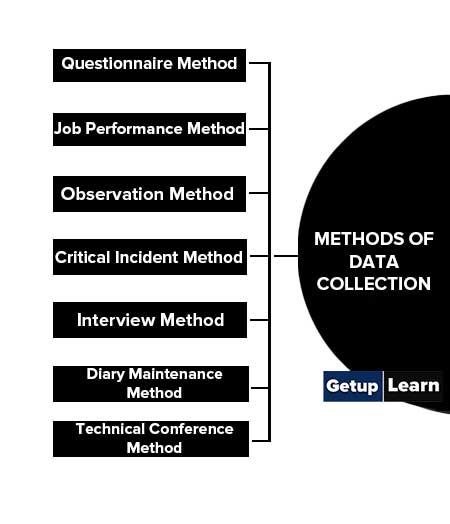
Questionnaire Method
Under this method, the analyst distributes questionnaires to the employees who are part of the job analysis. The responses would be analysed for collecting job-related information. For this structured or unstructured questionnaires could be used. One of the major advantages of this method is that it is the easiest and the most efficient method of data collection.
But it is also costly to administer and time-consuming. The following are a few popular models of questionnaires that are used:
1.Position Analysis Questionnaire (PAQ) model.
2.Functional Job Analysis (FJA) model.
3.Management position description (MPDQ) model.
4.Work Profiling System (WPS) model.
5.Multipurpose Occupational Systems Analysis Inventory, Close Ended Questionnaire (MOSAIC) model.
6.Common Metric Questionnaire (CMQ) model.
Job Performance Method
Under this method, the job which is analysed is performed by the analyst himself to understand how it is executed. This helps the analyst to collect information regarding the nature of the job, stress level, level of difficulties and extent of concentration.
One of the major disadvantages of this method is that this method is not suitable for all jobs. Certain sensitive jobs which have a high degree of risk cannot be analysed through this method. This method also cannot be employed where the performance of the job is highly dependent on specialised training and skills.
Observation Method
The job analyst closely observes the performance of the employee in the job and records the various tasks that are performed. On the basis of this, the analyst gathers first-hand information about the working conditions, activities involved, the time required to complete the job and so on.
This is a useful method for analysing jobs that are manual in nature and are completed in a short duration. This method cannot be used where the work involved is highly intellectual in nature.
Critical Incident Method
A critical incident is any significant incident that takes place in a job environment and forces the employee to respond. It is a snapshot of the normal course of business. This method aims at collecting critical information regarding the behaviour of the employees in a given situation.
The response of the employee about a certain situation is assessed and the result derived from the response of the employee is considered. The responses may or not become part of the job which depends on whether the issue was effectively addressed or not. The major disadvantage of this method is that it might be difficult to convert the behavioural response into information to be included in the job description.
Interview Method
Under this method, the job analyst asks the employee about the dimensions of the job. He then seeks the opinion of the supervisor of the employee to verify the accuracy of the information collected. Then an interview would be designed. The questions included should be realistic and uncomplicated and the questions should be presented to the employees in a clear and straightforward manner.
It should be ensured that the employee is comfortable and the interview place should be free from distractions. The doubts of the employees should be cleared and adequate response time should be given to the employee. One of the major advantages of this method is that it can be used for any type of job.
But on the other hand, this method is time-consuming and costly and the accuracy of this method depends on the experience of the analyst. The success of this method also depends on the subjectivity of the responses given by the employees.
Diary Maintenance Method
The analyst asks the employee to maintain a record of all the activities which are performed by him in chronological order. It should include the actual work undertaken as well as time devoted to its completion. This helps the employee to keep a track of activities which are performed by him.
The major advantage of this method is that employees are continuously involved in the process of job analysis. It might be possible that the activity of recording all the activities might become monotonous and time-consuming and so full cooperation of employees might not be available. The success of this method lies in the level of commitment of the employees which is again a limitation of this method.
Technical Conference Method
Under this method, a brainstorming session among the various supervisors is organised for collecting information about the various tasks associated with the jobs involved. The impact of inclusion or exclusion of a task on the overall job is discussed and on the basis of that, the final job description and job specification are arrived at.
The main advantage of this method is that the views of experts are sought so the results of job analysis are more sound. But this method is time-consuming and consensus between experts might be difficult to arrive at.
Challenges Affecting the Effective of Job Analysis
Many times, the job analysis process often is not effectively undertaken due to certain reservations from employers and employees. To effectively implement the job analysis, a few challenges have to be overcome which are as under:
2.Manager’s Attitude Towards Job Analysis
3.Undue Importance to Job Holders
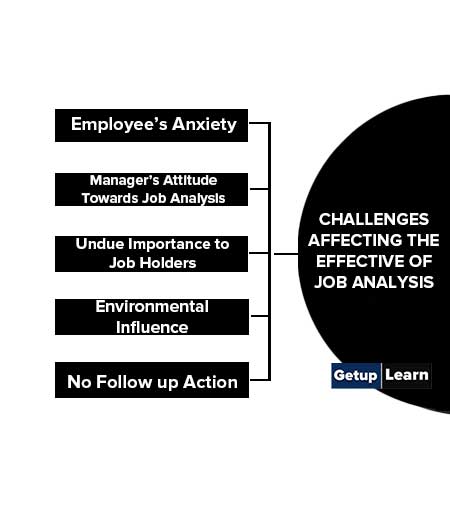
Employee’s Anxiety
Many times, employees panic when their jobs are scrutinized which may create uncertainty in minds of the employees. They might think that the job analyst may find some mistakes which they might have undertaken and due to this, they might not cooperate fully with the analyst in the job analysis process.
To avoid all these problems, it is essential that the management before undertaking the process of job analysis takes the employees into confidence by clarifying their doubts. They should also make them understand the final implications of the job analysis process and how it would be beneficial to them.
Manager’s Attitude Towards Job Analysis
During the job analysis process, it might be possible that the managers might feel that their control over their subordinates is being reduced. If they feel so, then they might not cooperate fully with the analyst. They might also not accurately summarise the job which might reduce the effectiveness of job analysis.
Undue Importance to Job Holders
During the process of job analysis, it might be possible that the job analysts might give more importance to the job than what is actually required. This might result in an overstatement of job characteristics. Due to this, it might result in the activity of the organisation finding a person to replace the person who is currently doing the job rather than finding out a suitable person for the job.
Environmental Influence
The existing environment and facilities of the organisation influence the process of job analysis. For e.g., if the job analysis is undertaken for understanding the context of technological changes then the employees might fear for their jobs. This might result in a strong opinion from trade unions. They might resist the process of job analysis. So, before undertaking a job analysis, the various environmental factors should be taken to account.
No Follow up Action
Many times, after undertaking the entire process of job analysis and completing it in a successful manner, the management might not initiate any follow-up action. In this case, the employees may lose their confidence in the entire procedure and may not cooperate in future for undertaking such an activity again.
What is a job analysis simple definition?
Job Analysis is the process of collecting, analysing and setting out info about the content of jobs in order to provide the basis for a job description and data for recruitment, training, job evaluation and performance management. BY Michael Armstrong
What are the benefits of job analysis?
These are the objectives of the job analysis given below:
1. Work Simplification
2. Establishes Standards
3. Support other Activities.
What are the uses of job analysis?
Following are the uses of job analysis:
1. Job Evaluation
2. Job Design
3. Job Classification
4. Job Description and Specification
5. Human Resource Planning
6. Recruitment and Selection
7. Training and Development
8. Performance Evaluation
9. Wage and Salary Administration
10. Safety and Health.
What are the steps in job analysis process?
Process of Job Analysis:
1. Determine the Purpose of Job Analysis
2. Gathering Background Information
3. Choosing Representative Jobs for Analysis
4. Collecting Relevant Job Information
5. Review of Information that is Collected
6. Developing Job Description and Job Specification etc.

